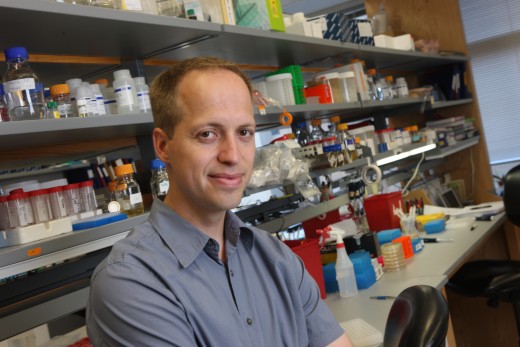A team of U of M and UC San Francisco researchers, led by CBS' Reuben Harris, have discovered a new target for HIV drug therapy that could make it possible for natural human antiviral proteins to destroy HIV.

Harris and doctoral student Judd Hultquist, working with UCSF researchers, learned that an HIV protein (called Vif) hijacks a human protein (called CBF-beta) and uses it to degrade the important antiviral protein, APOBEC3G.
“Our data show that if HIV is unable to hijack CBF-beta, it is unable to launch a counterdefense against our innate immune system and unable to replicate efficiently,” Hultquist explained.
Harris’s lab has long focused on a family of antiviral proteins (called APOBECs) produced by human cells that have the ability to destroy HIV. HIV has evolved a way to overcome that natural defense using Vif. This new data shows that Vif requires CBF-beta to function.
The finding presents a new target for antiviral drugs and helps scientists understand how HIV overcomes normal cellular defenses. The next step, Hultquist says, is to screen molecules in order to find one that could stop the Vif/ CBF-beta interaction. Harris’s lab has already initiated this process, but it could take years to find, develop and test the molecule.
“We hope this fundamental research will ultimately lead to a treatment that is more effective and has fewer side effects,” Harris said. “The main advantage is that HIV shouldn’t be able to evolve resistance to the new drug as easily as it has to other therapies.”
HIV is a small virus with only a tiny amount of genetic material in its own genome—about 10,000 times less DNA than that of the human genome. While human cells may include thousands of different proteins, HIV brings fewer than 20. Once inside a human cell, however, the virus uses the cell’s molecular machinery to hijack the function of many human proteins, shut down others and subvert still more. Understanding how HIV works within human cells and devising ways to block it are essential to developing new drugs to treat people with HIV/AIDS and ultimately eradicate this disease.
UCSF co-authors include Nevan Krogan, John Gross and members of their labs.
In a related Nature article published simultaneously, the Krogan group reported hundreds of new connections that HIV makes with other cellular proteins, and many of these will have to be explored in the same detail as the Vif-CBFbeta connection.
Last April, Harris was awarded a five-year, $10 million grant from the National Institutes of Health to direct a large-scale research effort involving several universities worldwide to study APOBEC3G. The goal of the study is to produce atomic resolution images of the antiviral protein to better understand how it interacts with other proteins in human cells and, when functioning as it should, prevents HIV from attaching to and entering cells.
- Peggy Rinard